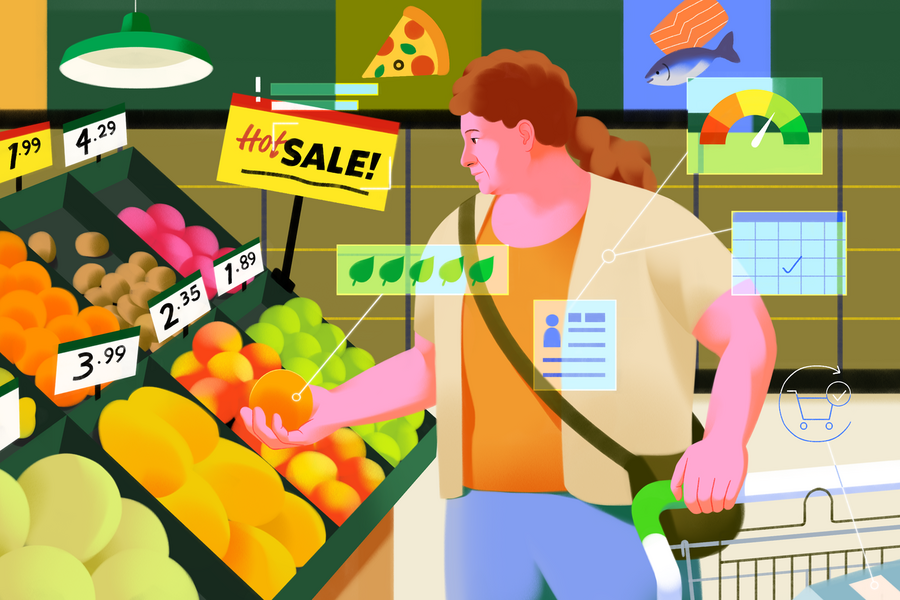Marketing Finance & Accounting Jun 1, 2025
No Credit History? No Problem.
A new type of score looks at people’s shopping behaviors and utility payments to determine their eligibility for loans and credit cards.

Jesús Escudero
Cigarettes, canned fish, and mortadella raise red flags. But beans, milk, and vinegar salad dressing suggest fiscal responsibility.
Those are the findings of a proof-of-concept paper “where we demonstrated that people’s shopping behavior in grocery stores correlated with their repayment of credit-card bills,” says Eric Anderson, a professor of marketing at the Kellogg School, who collaborated with Jung Youn Lee from Rice University and Joonhyuk Yang from the University of Notre Dame for the research.
They found that people who bought groceries that formed the basis of home-cooked meals, like beans and milk, were less likely to default on their credit-card payments. And that those who exercised discipline—by shopping on a consistent schedule, sticking with a budget, and buying items on sale—were also more likely to pay their credit card on time.
Building upon this earlier work, the researchers investigated how people’s shopping behavior across five retail sectors, including groceries, could be used to create an alternative credit score for those who don’t have a formal credit history.
Purchase histories can be like a window that gives lenders a better view of people’s actual financial reliability, says Anderson. And this additional information could help lenders feel more comfortable extending credit to the 1.4 billion individuals worldwide who lack access to formal financial services.
“Firms can use this score to make informed decisions about the creditworthiness of people who don’t have conventional credit scores,” he says.
A chicken-and-egg problem
Anderson notes that studying the creditworthiness of people who don’t have a formal credit history creates a chicken-and-egg problem. They don’t have a credit history because they rarely get loans, but in order to get a loan, they need a credit history.
“One of the main problems we run into in this work is that the people who don’t traditionally get loans might be different in important ways from the population that does get loans,” Anderson says, “and so predictions about their behavior don’t end up being that great because they simply aren’t represented in the data.”
The researchers were able to work their way around this challenge by collecting and comparing information from several distinct data sets.
“Populations without a credit history may generate the same amount of income as other customers, but it’s often not as consistent, which can lead to missed payments.”
—
Eric Anderson
The first came from the researchers’ partnership with a Peruvian conglomerate that operates five types of retail chains: supermarkets, pharmacies, department stores, shopping malls, and home-improvement stores. They gathered information on more than 45,000 consumers who made at least one purchase at a store between May 2021 and September 2023. They looked at variables like how responsive consumers were to promotions, how often they returned products, and what kinds of products they bought. These consumers also applied for a general-purpose credit card issued by the conglomerate during this period. Some of these applicants had credit histories; some did not. Some were approved for the card; some were not.
Another stream of data came from information the conglomerate purchased from a credit-rating agency in 2022, including details about the timeliness and consistency of individuals’ utility-bill payments. The conglomerate had used this data in a pilot program where it experimented with approving credit-card applicants who did not have formal credit histories.
Finally, the researchers collected a comprehensive monthly snapshot of people’s credit histories—including information such as outstanding debt, credit-card usage rates, and payment patterns—from a registry managed by Peru’s financial regulatory authority.
Insights from retail behavior
Merging this data allowed Anderson and his colleagues to create alternative credit scores for distinct groups of people: those with a credit history who were approved for the conglomerate’s credit card; those without a credit history who were approved for the card based on their utility-bill payments; and those without a credit history who were not approved for the conglomerate’s card but whose names still showed up in the national registry since they were approved for credit by other lenders.
The researchers used a series of algorithms to answer two questions about these groups of people. To whom did the conglomerate, in fact, decide to extend credit, and what was the result in terms of default rates? And second, how different would the picture have looked if the conglomerate offered credit based on the alternative credit score instead of conventional methods?
After simulating approval decisions based on these alternative credit scores, Anderson says, “we show that the score we produced does much better at forecasting credit risk than [traditional credit scores] or utility bills alone.”
What’s more, the researchers used this alternative credit score to demonstrate several ways the Peruvian conglomerate could have improved its credit decisions.
First, by using the alternative credit score, the company could have kept the same risk threshold for approving credit-card applicants while tripling its credit-card approval rate for people without a credit history—from 15.6 percent to 47.8 percent. The downside is that it would have increased the default rate for these customers by 0.76 percent, which “in the world of banking is a pretty big number,” Anderson says.
Alternatively, the company could have kept its current default rate steady and still doubled its approvals for those without a conventional credit score, from 15.6 percent to 31.3 percent.
Finally, if the company preferred to maintain its 15.6 percent approval rate for those without credit histories, using the alternative credit approach could have reduced the default rate for these customers from 4.74 percent to 3.31 percent—again, a sizable amount in the banking world.
The challenge of applying this model
Building and putting this model into practice, Anderson admits, presents a number of challenges. First among them are privacy regulations. Laws that protect consumer data, while important on many fronts, impede researchers and startups invested in building unconventional models of creditworthiness. Without input about what people buy and when—information that isn’t widely available in the U.S.—the models don’t work.
Lenders interested in offering credit to borrowers without a formal credit history may also need to reconsider conventional approaches to customer default.
“Populations without a credit history may generate the same amount of income as other customers, but it’s often not as consistent, which can lead to missed payments,” Anderson says. “Part of this work is understanding novel ways to support these borrowers. If companies are simply punitive and cut off credit after the first missed payment, that may not be an effective strategy in the long run.”
Finally, and perhaps most fundamentally, companies may need to recalibrate their appetite for risk. Lending to “unbanked” people presents an opportunity to both make more money and improve society’s financial well-being, but the researchers’ model is not perfect. It does not, for example, capture the population of consumers who never showed up in the national registry—that is, who never received a loan from the conglomerate or other institutions.
To truly validate this kind of alternative credit score, lenders like the Peruvian conglomerate need to test it out in the real world, Anderson says.
“But that requires lenders to take on some risk, and that’s the tension in the paper: firms could make more money by lending to more people, but they believe it’s a risky group, and so they don’t lend to them, and they don’t get the information they need,” he says. “As long as these beliefs are maintained, we’ll never solve the problem.”
Sachin Waikar is a freelance writer based in Evanston, Illinois.
Lee, Jung Youn, Joonhyuk Yang, and Eric T. Anderson. 2025. “Who Benefits from Alternative Data for Credit Scoring? Evidence from Peru.” Working paper.



